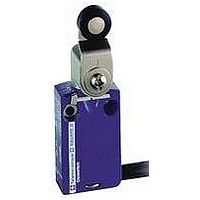XCMD2116L1 SQUARE D, XCMD2116L1 Datasheet - Page 208

XCMD2116L1
Manufacturer Part Number
XCMD2116L1
Description
LIMIT SWITCH, 1NO.1NC, 240VAC, 250VDC, 6A
Manufacturer
SQUARE D
Datasheet
1.XCKD2102N12.pdf
(246 pages)
Specifications of XCMD2116L1
Actuator Style
Roller Lever
Operating Force Max
0.1N
Switch Operation
(ON)
Contact Voltage Ac Max
240V
Contact Voltage Dc Max
250V
Contact Current Ac Max
6A
Contact Current Dc Max
6A
Lead Free Status / RoHS Status
Contains lead / RoHS non-compliant
- Current page: 208 of 246
- Download datasheet (20Mb)
Limit Switches
9007C Heavy Duty Industrial
Technical Information
208
© 1997–2007 Schneider Electric All Rights Reserved
Slow break contacts—The speed of transfer of the moveable contacts is dependent on the speed of the
operator. The amount of travel of the moveable contacts is also dependent on the amount of travel by the
operator. Slow make and break contacts have the same trip and reset points, and do not have the
differential travel common to snap switches.
Snap action contacts—The speed of transfer of the moveable contacts is not dependent on the speed
of the operator. The amount of travel of the moveable contacts is also not dependent on the amount of
travel by the operator. The movement of the moveable contacts are determined by a preset travel, after
this point is reached, the contacts will trip. Snap action contacts have different trip and reset points, the
difference is identified as “differential.”
Flexible operators—Flexible resilient or elastic operators, i.e., wobble sticks, do not ensure direct
opening/positive opening action.
Isolated contacts—Single-pole double-throw (SPDT) contacts with four terminals which have two
isolated contact bars mechanically linked. No polarity restrictions apply. Different (isolated) power
supplies can also be applied.
Same polarity—Single-pole double throw (SPDT) contacts with four terminals that require the supply to
be applied with the same polarity (i.e., L1 or +) on the same side of the contact bar. Two different
supplies are not allowed in this configuration. (The loads should always be on the same side of the
contact bar.)
Direct opening contact (also known as positive opening contacts)—A normally closed contact
element coupled with the switch actuator via a non-resilient (non-elastic) member so that full contact
opening is obtained when the actuator is moved through the direct opening travel by applying a direct
opening force. The contact element will shear open in the event of sticking contacts or broken springs.
Proper fusing of the control circuit is required. Direct opening contacts meet IEC 60947-5-1
requirements.
Direct opening travel (also known as positive opening travel)—Minimum travel from the actuator
free position to the position where the direct opening operation is completed. Usually longer than the
normal pre-travel.
Reed contacts—Contact mechanism consists of a set of contacts hermetically sealed in a glass
envelope and actuated by a magnet attached to the operator. This sealed construction keeps
contaminants out of the contact area, making the reed switch the ideal switch for low voltage, low current
circuits such as programmable controllers.
NOTE: Because reed switches are operated by a magnet, they should not be installed in areas where strong magnetic
fields may be present. The devices should always be checked for proper operation after installation.
Definition
Polarity
Opposite polarities should not be
connected to the contacts of one limit
switch unless the limit switch is
specifically designed for such service
(isolated contacts—no polarity). See
page 209.
Incorrect
Correct
Power sources
Power from different sources should not
be connected to the contacts of one limit
switch unless the switch is specifically
designed for such service (isolated
contacts—no polarity).
DC
AC
Incorrect
IM
CR
03/2007
Related parts for XCMD2116L1
Image
Part Number
Description
Manufacturer
Datasheet
Request
R

Part Number:
Description:
Pushbutton, Non-Illum'd Red "STOP", Momentary, 1NO-1NC, Square 30mm, 10A, 600V
Manufacturer:
SQUARE D
Datasheet:

Part Number:
Description:
KITS,TWIDO? PROGRAMMABLE CONTROLLERS,KITS,TWIDOPACK STARTER KIT - ADVANCED LEVEL,PROGRAMMABLE CONTROLLERS,TWIDO? PROGRAMMABLE CONTROLLERS ,SQUARE D
Manufacturer:
SQUARE D

Part Number:
Description:
LAMPS,INDICATOR,STACKABLE,LAMPS, STACKABLE INDICATOR,VISUAL INDICATING SIGNALS,XVB SERIES INDICATING BANKS ,SQUARE D
Manufacturer:
SQUARE D

Part Number:
Description:
LAMPS,INDICATOR,STACKABLE,LAMPS, STACKABLE INDICATOR,VISUAL INDICATING SIGNALS,XVB SERIES INDICATING BANKS ,SQUARE D
Manufacturer:
SQUARE D
Datasheet:

Part Number:
Description:
I/O EXTENDER MODULE 4 D IN & 2 D OUTPUT
Manufacturer:
SQUARE D
Datasheet:

Part Number:
Description:
CB ACCESSORY, UNDERVOLTAGE TRIP 48V DC
Manufacturer:
SQUARE D
Datasheet:











